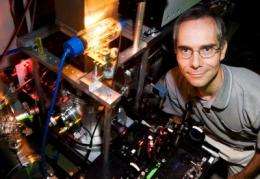University of Illinois chemistry professor Martin Gruebele led a group that directly observed two-state dynamics in glassy silicon for the first time. Credit: L. Brian Stauffer
Using high-resolution imaging technology, University of Illinois researchers have answered a question that had confounded semiconductor researchers: Is amorphous silicon a glass? The answer? Yes – until hydrogen is added.
Led by chemistry professor Martin Gruebele, the group published its results in the journal Physical Review Letters.
Amorphous silicon (a-Si) is a semiconductor popular for many device applications because it is inexpensive and can be created in a flexible thin film, unlike the rigid, brittle crystalline form of silicon. But the material has its own unusual qualities: It seems to have some characteristics of glass, but cannot be made the way other glasses are.
Most glasses are made by rapidly cooling a melted material so that it hardens in a random structure. But cooling liquid silicon simply results in an orderly crystal structure. Several methods exist for producing a-Si from crystalline silicon, including bombarding a crystal surface so that atoms fly off and deposit on another surface in a random position.
A time-lapse video of an amorphous silicon surface. The lumps are clusters of about five atoms of silicon. The "hopping" motion of the lumps shows that a-Si is a glass. Credit: Martin Gruebele
To settle the debate on the nature of a-Si, Gruebele's group, collaborating with electrical and computer engineering professor Joseph Lyding's group at the Beckman Institute for Advanced Science and Technology, used a scanning tunneling microscope to take sub nanometer-resolution images of a-Si surfaces, stringing them together to make a time-lapse video.
The video shows a lumpy, irregular surface; each lump is a cluster about five silicon atoms in diameter. Suddenly, between frames, one bump seems to jump to an adjoining space. Soon, another lump nearby shifts neatly to the right. Although few of the clusters move, the action is obvious.
Such cluster "hopping" between two positions is known as two-state dynamics, a signature property of glass. In a glass, the atoms or molecules are randomly positioned or oriented, much the way they are in a liquid or gas. But while atoms have much more freedom of motion to diffuse through a liquid or gas, in a glass the molecules or atom clusters are stuck most of the time in the solid. Instead, a cluster usually has only two adjoining places that it can ferry between.
"This is the first time that this type of two-state hopping has been imaged in a-Si," Gruebele said. "It's been predicted by theory and people have inferred it indirectly from other measurements, but this is the first time we're been able to visualize it."
The group's observations of two-state dynamics show that pure a-Si is indeed a glass, in spite of its unorthodox manufacturing method. However, a-Si is rarely used in its pure form; hydrogen is added to make it more stable and improve performance.
Researchers have long assumed that hydrogenation has little to no effect on the random structure of a-Si, but the group's observations show that this assumption is not quite correct. In fact, adding hydrogen robs a-Si of its two-state dynamics and its categorization as a glass. Furthermore, the surface is riddled with signs of crystallization: larger clusters, cracks and highly structured patches.
Such micro-crystalline structure has great implications for the properties of a-Si and how they are studied and applied. Since most research has been conducted on hydrogenated a-Si, Gruebele sees a great opportunity to delve into the largely unknown characteristics of the glassy state.
"In some ways, I think we actually know less about the properties of glassy silicon than we think we do, because a lot of what's been investigated of what people call amorphous or glassy silicon isn't really completely amorphous," Gruebele said. "We really need to revisit what the properties of a-Si are. There could yet be surprises in the way it functions and the kind of things that we might be able to do with it."
Next, the group hopes to conduct temperature-depended studies to further establish the activation barriers, or the energy "humps" that the clusters must overcome to move between positions.
More information: Direct Imaging of Two-State Dynamics on the Amorphous Silicon Surface, Phys. Rev. Lett. 106, 235501 (2011) DOI:10.1103/PhysRevLett.106.235501
Abstract
Amorphous silicon is an important material, amidst a debate whether or not it is a glass. We produce amorphous Si surfaces by ion bombardment and vapor growth, and image discrete Si clusters which hop by two-state dynamics at 295 K. Independent of surface preparation, these clusters have an average diameter of ∼5 atoms. Given prior results for metallic glasses, we suggest that this cluster size is a universal feature. The hopping activation free energy of 0.93±0.15 eV is rather small, in agreement with a previously untested surface glass model. Hydrogenation quenches the two-state dynamics, apparently by increasing surface crystallinity.
Provided by University of Illinois at Urbana-Champaign



















